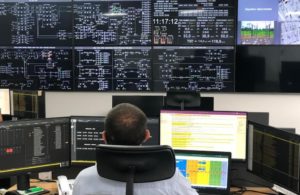How does an Electrical System Operations Center work?
 From Florianópolis (SC), it is possible to disconnect a transformer from a substation located in the middle of the Amazon Forest, between the states of Pará and Amapá, where it is only possible to access it in person by ferry. This is one of the several activities that a System Operations Center (COS) of an Operation and Maintenance (O&M) company is responsible for executing the dispatch of asset loads in a way for better systemic balance.
From Florianópolis (SC), it is possible to disconnect a transformer from a substation located in the middle of the Amazon Forest, between the states of Pará and Amapá, where it is only possible to access it in person by ferry. This is one of the several activities that a System Operations Center (COS) of an Operation and Maintenance (O&M) company is responsible for executing the dispatch of asset loads in a way for better systemic balance.
The electrical assets equipment, such as transmission lines, substations, wind and solar sets, hydroelectric plants, wind farms feeders, auxiliary service systems and generating units can be controlled through an environment full of large monitors, constantly supervised by professionals through monitoring of analog and digital quantities.
An Operation Center operates 24 hours a day, seven days a week, remotely executing the shutdown, isolation and normalization maneuvers when adjustments or recompositions of equipment or installation are necessary. In this way, the local maintenance team has safe conditions to carry out the necessary interventions.
The advantages of remotely operating installations from an operations center are numerous:
– reduction of operating costs;
– greater investments in the qualification of operators and technological resources in the operation centers;
– reduction of risks arising from the displacement of operators, especially in regions with difficult access, and in unfavorable weather conditions that may even make access difficult or impossible.
Competencies of a SOC
An Operations Center has an internal structure that is easy to interact with, but physically separated, mainly to provide a comfortable and focused environment for operators.
Schedule:
It performs the analysis of internal and external intervention requests, prepares maneuver plans for equipment isolation, communicates with the ONS programming areas and other agents. It also consolidates the Daily Energy Production Program.
Real time:
Monitors and commands equipment, ensuring their normal operating range. It performs maneuvers demanded by the ONS and other agents and maneuvers for isolation and normalization of equipment.
Post-operation:
It prepares reports with the necessary indicators and manages the SATRA, SAMUG and AMSE environments, consisting of or contesting ONS launches.
Standardization:
It prepares manuals, studies and work instructions for operators, in accordance with the Grid Procedures, in particular the Operating Procedure Manual and internal instructions. It aims to bring operators the necessary information quickly, accurately and safely.
Telecom:
It maintains the telecommunications systems in full operation, guaranteeing the tele-assistance indicators of the Network Procedures.
Automation and implementation of new projects:
Deploys new installations to the COS, developing communication drives, Elipse screens, alarm and event lists. In addition to the maintenance of the system already installed, it guarantees the tele-assistance indicators of the Network Procedures.
Communication with bodies
The communication of an Operations Center with agents of the National Electric System Operator (ONS) and with the assets themselves is carried out through terrestrial and satellite links, always being recorded through voice recording systems.
In order to guarantee the fidelity of the messages and preserve the security of the electrical system, the real-time team interacts with the ONS and other companies that share the same System, through a standard language that must comply with the ONS Operation Procedures Manual.
Communication systems must have high availability, meeting the minimum criterion of 99.98%, that is, in an entire year the communication system cannot fail for more than 105 minutes. For this, the entire system must have redundancies that guarantee such performance.
Infrastructure
The infrastructure of a real-time Operations Center must respect, in addition to ergonomic issues, suitable for operators to respect the requirements of sub-module 2.16 network procedure, to which they highlight
– Operating room backup;
– Digital security and protection against cyber attacks;
– Voice recording between COS and plants and between COS and ONS;
– Real-time monitoring of communication links.
– External AC (Alternating Current) source and another redundant source, in addition to no-breaks that keep the system active during source switching.
Real Time Cotesa Engenharia
Critical assets of great relevance to the National Interconnected System (SIN) are serviced, such as Type I, II (A,B,C) and Substations, in addition to complying with the requirements of network procedures.
Cotesa Engenharia is able to operate any type of Asset, both Generation and Transmission of Energy, such as: High and Extra High Voltage Substations, Photovoltaic Plants, Wind and Hydroelectric Plants.
COTESA's operational challenges are constant and the company remains vigilant in fully complying with the network procedures established by the National System Operator, as well as with a great commitment to efficiency in the management and dispatch of our customers' assets.
Efficient real-time operation promotes reliability within the Electrical System as well as for the entire community.
